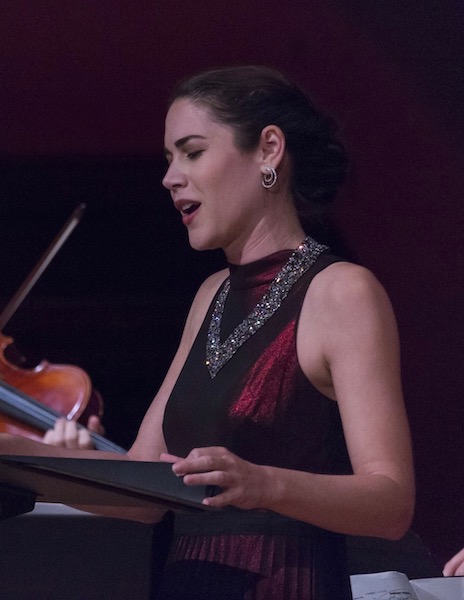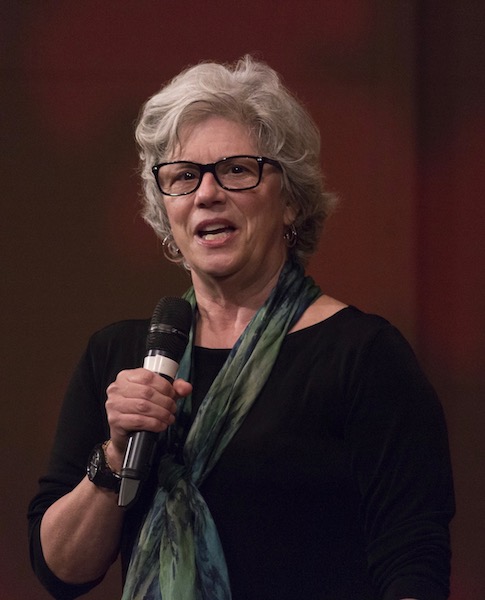Ensemble Ibis illuminates music of Melinda Wagner and others

The music of Melinda Wagner, the University of Miami Frost School of Music’s 2019 composer in residence, was the featured event in a program by Ensemble Ibis of widely varied contemporary music Wednesday night at UM Gusman Concert Hall. A superbly crafted song cycle by Wagner was the clear high point of the evening but all of the works presented under the direction of Shawn Crouch were worthy and compelling.
Two Organa by Oliver Knussen was an engaging opener. Knussen, who died in 2018, was one of England’s most celebrated composers and specialist conductors. He led the premieres of numerous contemporary works and taught extensively in Europe and America.
The two-movement 1995 score is prime Knussen, combining ancient and modern in blooming instrumental colors. Based on 12th century plainchant tones, the work is ecstatic and rousing. Knussen’s conservative musical underpinnings are spiced with modernist harmonics.
The opening “Notre Dame des Jouets” was dedicated to the late British composer Sir Peter Maxwell Davies on his 60th birthday and is appropriately festive. In the second movement “Organum to honor the 20th anniversary of the Schoenberg Ensemble,” Baroque counterpoint takes unexpected paths. A more pessimistic aura pervades the densely constructed vignette. Yet, for all its complexity, Knussen’s creation flows in a wonderfully natural manner. Crouch led the Frost School’s contemporary ensemble in an urgent, meticulously detailed performance. The exposed horn part was played with strong precision by Jaquelyn Hernandez who substituted at the last minute for a player who did not appear.
Quartettrope by Frost faculty member Lansing McLoskey is a modern updating of the Medieval “trope” – the insertion of newly composed music into an existing composition. Webern’s Quartett, op. 22 provides the framework and instrumentation for McLoskey’s 2008 work.
In his preperformance remarks, the composer said the composition was the most challenging he had ever written. Webern’s iconic chamber vignette in heard in its entirety with McLoskey’s additions melded into the two movements. Typical Webern fragmentary motifs commence the first movement with McLoskey’s rhythmically vigorous writing providing a counterweight. His bluesy, jagged riffs for the saxophone add a whiff of jazz to the mix.
The second movement spotlights an elongated violin solo utilizing the same tone rows as Webern before taking off on its own neo-romantic journey. There is tremendous ingenuity in McLoskey’s fusing of voices, both instrumental and creative. The result is a finely wrought essay that holds the listener’s attention. Crouch skillfully led the four excellent players through the numerous bends and changes of meter. The bright tone of Yuhao Zhou’s violin and Frank Capoterri”s agile saxophone took special honors with clarinetist Tina Vafiadis and pianist Jacob Mason exhibiting strong ensemble skills.
The Frost Percussion Group took center stage for Alejandro Vinao’s Stress and Flow. The Argentine born, London based Vinao adds electronics to a four-member (mostly) mallet percussion ensemble. The electronics are most prominent in ‘The Sound Behind” where drone-like sounds emerge from the speakers against the slow lines of the players (with chimes added to the marimbas and xylophone). In the outer movements, Vinao’s hypnotic, fast-paced whirls of color brings some of the best writing for mallet instruments this side of Steve Reich. Noel Holloway, Kosuke Matsuada, Mitya Nilov and Antek Olesik were the superb players whose deft teamwork made Vinao’s gleaming array of timbres sparkle.

Melinda Wagner described herself as “a romantic at heart” despite the dissonance and fierce agitation of some of her music. Her Romanze and Faux Variations (2008) certainly proved that true. Throbbing and foreboding thematic lines in the violin and cello’s lower registers open the work. The ensuing quasi-variations are replete with incident, light and dark hues and thematic transformation. There is great imagination and skill in this finely wrought trio. Kyle Pearl’s burnished cello solo and Kira Wales’ singing violin sonority encompassed the work’s passionate moods with Mason providing more tart interjections at the piano.
Wagner’s Four Settings for soprano and seven players was the evening’s pinnacle. This 2004 song cycle (written for the Chamber Music Society of Lincoln Center) is a superb delineation of light versus darkness through the stanzas of three poets.
“Last Poem” brings Bergian lyricism to the final written words of French poet Robert Desnos who died in a concentration camp. An agitated keyboard and ensemble prelude sets up the soaring vocal lines of “The Wings” (to a text by Denise Levertov), aptly rendered by soprano Madeline Harts, her high register taking avian flight.
Two contrasted Emily Dickinson poems displayed Wagner’s smart combination of timbral hues. “Safe in Their Alabaster Chambers” was operatic, suggesting Samuel Barber but with a leaner instrumental palette. “Wild Nights” brought the singer and players into the stratosphere with pulsating emotional underpinnings. Harts’ freely produced top and dark midrange brought weight and agility to Wagner’s beautiful vocal writing. Crouch drew out the distinctive tonal shades of the individual instruments. Redi Lupa was a standout for his virile projection of the thorny keyboard part.
A largely student audience deservedly cheered Wagner and the performers. The entire concert was a model, in terms of both repertoire choices and painstaking rehearsal, of first rate, adventurous contemporary music programming.
Gerard Schwarz conducts the Frost Symphony Orchestra in Stravinsky’s Song of the Nightingale and Mahler’s Symphony No. 7, 7:30 p.m. November 16 at UM Gusman Concert Hall. ci.ovationtix.com
Posted in Performances
Leave a Comment
Thu Nov 7, 2019
at 2:30 pm
No Comments